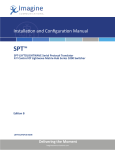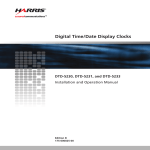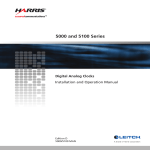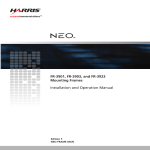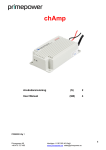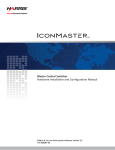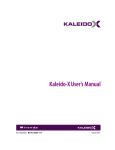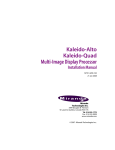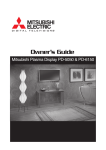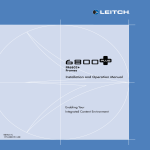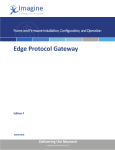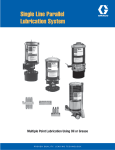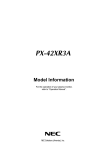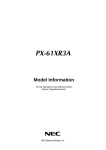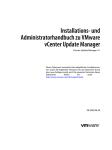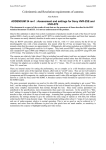Download SPT-LXYTOTSLUMD Installation and Configuration Manual
Transcript
Installation and Configuration Manual
SPT
TM
SPT-LXYTOTSLUMD Serial Protocol Translator
X-Y to Under Monitor Display Using TSL Protocol
Edition D
LXYTOTSLUMD MAN
Delivering the Moment
Publication Information
© 2014 Imagine Communications Corp. Proprietary and Confidential.
Imagine Communications considers this document and its contents to be proprietary and confidential.
Except for making a reasonable number of copies for your own internal use, you may not reproduce this
publication, or any part thereof, in any form, by any method, for any purpose, or in any language other
than English without the written consent of Imagine Communications. All others uses are illegal.
This publication is designed to assist in the use of the product as it exists on the date of publication of this
manual, and may not reflect the product at the current time or an unknown time in the future. This publication does not in any way warrant description accuracy or guarantee the use for the product to which it
refers.
Imagine Communications reserves the right, without notice to make such changes in equipment, design,
specifications, components, or documentation as progress may warrant to improve the performance of
the product.
Trademarks
SPT, CCS, CCS CoPilot, CCS Navigator, CCS Pilot, Command Control System, CineTone, CinePhase,
CineSound, DigiBus, DigiPeek, Digital Glue, DigiWorks, DTV Glue, EventWORKS, EZ HD, Genesis, HDTV
Glue, Image Q, Inca, Inca Station, InfoCaster, Inscriber, Inscriber CG—FX, Harris, Icon, IconLogo,
IconMaster, IconMaster Nav, IconSet, IconStation, Integrator, LeFont, Leitch, LogoMotion, MediaFile,
MIX BOX, NEO, the NEO design, NEOSCOPE, NewsFlash, Nexio, Opus, Panacea, PanelMAPPER, Platinum,
Portal, PROM-Slide, RouterMAPPER, RouterWORKS, Signal Quality Manager, SpyderWeb, SuiteView,
TitleMotion, UNIFRAME, Velocity, VelocityHD, VideoCarte, Videotek, and X75 are trademarks of Imagine
Communications or its subsidiaries. Microsoft® and Windows® are registered trademarks of Microsoft
Corporation.All other trademarks and trade names are the property of their respective companies.
Contact Information
Imagine Communications has office locations around the world. For locations and contact information see:
http://www.imaginecommunications.com/contact us/
Support Contact Information
For support contact information see:
▪▪
Support Contacts: http://www.imaginecommunications.com/services/technical support/
▪▪
eCustomer Portal: http://support.imaginecommunications.com
Preliminary—Contents are proprietary and confidential. Do not photocopy or distribute.
Contents
Preface
Manual Information.................................................................................................. v
Purpose .............................................................................................................. v
Audience............................................................................................................ v
Revision History................................................................................................ v
Writing Conventions ........................................................................................ vi
Obtaining Documents....................................................................................... vi
Unpacking/Shipping Information .......................................................................... vii
Unpacking a Product ....................................................................................... vii
Returning a Product......................................................................................... vii
Compliance and Safety Standards ........................................................................viii
Restriction on Hazardous Substances (RoHS) Compliance...........................viii
Waste from Electrical and Electronic Equipment
(WEEE) Compliance......................................................................................viii
Safety....................................................................................................................... ix
Safety Terms and Symbols in this Manual....................................................... ix
Chapter 1: Introduction
Applications Involving the SPT-LXYTOTSLUMD ............................................... 2
Chapter 2: Installation
Installing the SPT-LXYTOTSLUMD...................................................................... 3
Cable Wiring Details ................................................................................................ 5
Power Requirements ................................................................................................ 6
Chapter 3: Configuration and Assembly
Configuring the SPT-LXYTOTSLUMD ................................................................. 9
Reassembling the Unit ........................................................................................... 12
Protocol Notes ....................................................................................................... 13
SPT-LXYTOTSLUMD RouterMapper Configuration Procedure ................. 13
Text Displayed on the UMD .......................................................................... 17
Monitoring Levels .......................................................................................... 17
References ............................................................................................................. 18
Overview ................................................................................................................ 19
SPT-LXYTOTSLUMD Installation and Configuration Manual
iii
Preliminary—Contents are proprietary and confidential. Do not photocopy or distribute.
Contents
Safety Terms and Symbols in this Manual ............................................................ 20
Safety Terms and Symbols on the Product............................................................. 20
Preventing Electrostatic Discharge ........................................................................ 21
Injury Precautions................................................................................................... 21
Product Damage Precautions.................................................................................. 22
EMC and Safety Standards .................................................................................... 24
EMC Standards .............................................................................................. 24
Additional EMC Information ......................................................................... 25
Safety Standards ............................................................................................. 26
Index
Keywords ............................................................................................................... 27
iv
SPT-LXYTOTSLUMD Installation and Configuration Manual
Preface
Manual Information
Purpose
This manual details the features, configuration details, and specifications for the
SPT-LXYTOTSLUMD serial protocol translator.
Audience
This manual is written for technicians and operators responsible for installation,
setup, maintenance, and/or operation of the product, and is useful to operations
personnel for purposes of daily operation and reference.
Revision History
Table P-1. Manual Revision History
Edition
Date
Comments
Edition A
August 2002
Initial release
Edition B
March 2003
Various edits and updates
Edition C
September 2002
• Updated jumper designators
• Added RouterMapper information
Edition D
June 2007
• Added power requirements information
• Added RoHS-WEEE compliance information
• Added index
SPT-LXYTOTSLUMD Installation and Configuration Manual
v
Preface
Writing Conventions
To enhance your understanding, the authors of this manual have adhered to the
following text conventions:
Table P-2. Writing Conventions
Term or
Convention
Description
Bold
Indicates dialog boxes, property sheets, fields, buttons, check
boxes, list boxes, combo boxes, menus, submenus, windows,
lists, and selection names
Italics
Indicates email addresses, the names of books or publications,
and the first instances of new terms and specialized words that
need emphasis
CAPS
Indicates a specific key on the keyboard, such as ENTER, TAB,
CTRL, ALT, or DELETE
Code
Indicates variables or command-line entries, such as a DOS
entry or something you type into a field
>
Indicates the direction of navigation through a hierarchy of
menus and windows
hyperlink
Indicates a jump to another location within the electronic
document or elsewhere
Internet address
Indicates a jump to a Web site or URL
Note
Indicates important information that helps to avoid and
troubleshoot problems
Obtaining Documents
Technical documents can be viewed or downloaded from our Web site at
www.broadcast.harris.com/leitch (go to Support > Documentation).
Alternatively, contact your Customer Service representative to request a
document.
vi
SPT-LXYTOTSLUMD Installation and Configuration Manual
Preface
Unpacking/Shipping Information
Unpacking a Product
This product was carefully inspected, tested, and calibrated before shipment to
ensure years of stable and trouble-free service.
1. Check equipment for any visible damage that may have occurred during
transit.
2. Confirm that you have received all items listed on the packing list.
3. Contact your dealer if any item on the packing list is missing.
4. Contact the carrier if any item is damaged.
5. Remove all packaging material from the product and its associated
components before you install the unit.
Keep at least one set of original packaging, in the event that you need to return a
product for servicing.
Returning a Product
In the unlikely event that your product fails to operate properly, please contact
Customer Service to obtain a Return Authorization (RA) number, then send the
unit back for servicing.
Keep at least one set of original packaging in the event that a product needs to
be returned for service. If the original package is not available, you can supply
your own packaging as long as it meets the following criteria:
•
The packaging must be able to withstand the product’s weight.
•
The product must be held rigid within the packaging.
•
There must be at least 2 in. (5 cm) of space between the product and the
container.
•
The corners of the product must be protected.
Ship products back to us for servicing prepaid and, if possible, in the original
packaging material. If the product is still within the warranty period, we will
return the product prepaid after servicing.
SPT-LXYTOTSLUMD Installation and Configuration Manual
vii
Preface
Compliance and Safety Standards
Appendix A: “Safety Precautions, Certifications, and Compliances” contains
product compliance and safety standards.
Restriction on Hazardous Substances (RoHS) Compliance
Directive 2002/95/EC—commonly known as the European Union (EU)
Restriction on Hazardous Substances (RoHS)—sets limits on the use of certain
substances found in electrical and electronic equipment. The intent of this
legislation is to reduce the amount of hazardous chemicals that may leach out of
landfill sites or otherwise contaminate the environment during end-of-life
recycling. The Directive takes effect on July 1, 2006, and it refers to the
following hazardous substances:
•
Lead (Pb)
•
Mercury (Hg)
•
Cadmium (Cd)
•
Hexavalent Chromium (Cr-V1)
•
Polybrominated Biphenyls (PBB)
•
Polybrominated Diphenyl Ethers (PBDE)
According to this EU Directive, all products sold in the European Union will be
fully RoHS-compliant and “lead-free.” (See our Web site, www.broadcast.harris.com/leitch > company > environmental compliance, for more information on
dates and deadlines for compliance.) Spare parts supplied for the repair and
upgrade of equipment sold before July 1, 2006 are exempt from the legislation.
Equipment that complies with the EU directive will be marked with a
RoHS-compliant emblem, as shown in Figure P-1.
Figure P-1. RoHS Compliance Emblem
Waste from Electrical and Electronic Equipment
(WEEE) Compliance
The European Union (EU) Directive 2002/96/EC on Waste from Electrical and
Electronic Equipment (WEEE) deals with the collection, treatment, recovery,
and recycling of electrical and electronic waste products. The objective of the
WEEE Directive is to assign the responsibility for the disposal of associated
hazardous waste to either the producers or users of these products. Effective
August 13, 2005, producers or users will be required to recycle electrical and
electronic equipment at end of its useful life, and may not dispose of the
equipment in landfills or by using other unapproved methods. (Some EU
member states may have different deadlines.)
viii
SPT-LXYTOTSLUMD Installation and Configuration Manual
Preface
In accordance with this EU Directive, companies selling electric or electronic
devices in the EU will affix labels indicating that such products must be properly recycled. (See our Web site, www.broadcast.harris.com/leitch > company >
environmental compliance, for more information on dates and deadlines for
compliance.) Contact your local sales representative for information on returning these products for recycling. Equipment that complies with the EU directive
will be marked with a WEEE-compliant emblem, as shown in Figure P-2.
Figure P-2. WEEE Compliance Emblem
Safety
Carefully review all safety precautions to avoid injury and prevent damage to
this product or any products connected to it. You will find a complete list of
safety precautions in Appendix A. Any user-serviceable components (such as
fuses or batteries) are only replaceable by those components listed in the
manual.
IMPORTANT! Only qualified personnel should perform service procedures.
Safety Terms and Symbols in this Manual
WARNING
Statements identifying conditions or practices
that may result in personal injury or loss of life.
High voltage is present.
CAUTION
Statements identifying conditions or practices
that can result in damage to the equipment or
other property.
SPT-LXYTOTSLUMD Installation and Configuration Manual
ix
Preface
x
SPT-LXYTOTSLUMD Installation and Configuration Manual
Chapter 1
Introduction
The SPT serial protocol translator is a compact adapter that translates between
Harris protocol and protocols used by other manufacturers or equipment. The
SPT can be used to integrate otherwise incompatible devices in a system, and it
may be used to expand a system beyond the normal limitations imposed by
hardware or system design. The SPT is available in several modes, each of
which is covered in a separate manual. For a complete list of available models,
refer to the SPT Applications Guide.
Figure 1-1. SPT Serial Protocol Translator
SPT-LXYTOTSLUMD Installation and Configuration Manual
1
Chapter 1: Introduction
Applications Involving the SPT-LXYTOTSLUMD
The SPT-LXYTOTSLUMD can be used with any Under Monitor Display
(UMD) that uses TSL protocol, such as the Megahertz Under Monitor Display1.
The UMD is assigned a destination to display the status name of the source that
is currently switched to its destination. In this case the UMD uses TSL protocol.
The status of the Destinations and switching is in X-Y protocol. So it is
necessary to use this SPT to translate the X-Y protocol to TSL protocol. The
SPT statuses the proper destinations for the UMD(s) to display. When the status
is received for each of the UMD(s) on the SPT branch of the X-Y bus, the SPT
translates that status to TSL protocol and transmits this information over the
RS-422 line to the UMD to display, as shown in Figure 1-2.
Effectively, this adds a TSL protocol for “Under Monitor Display” capability to
the Harris routing and control system.
VTR 3
VTR 3
VTR 3
VTR 3
PS2
PS1
PS2
PS1
ERROR
FAN X-Y P.S.
ERROR
FAN X-Y P.S.
Se ria l Protoc ol Trans la tor
Mh
Mh
Figure 1-2. System Using SPT-LXYTOTSLUMD
1
The Megahertz Under Monitor Display is a product of Megahertz Broadcast Systems Ltd.,
Cambridge, United Kingdom.
2
SPT-LXYTOTSLUMD Installation and Configuration Manual
Chapter 2
Installation
Installing the SPT-LXYTOTSLUMD
The SPT-LXYTOTSLUMD is installed in the control line, as shown in
Figure 2-1.
•
The maximum allowable distance for each segment of the X-Y coaxial
cable run is 2,000 ft (609 m).
•
The maximum length for each RS-232 and RS-422 segment is 2,000 ft
(609 m).
•
There is no limit to the number of control devices added to the X-Y control
bus.
•
Each SPT can control up to 31 UMDs on one level.
•
For additional UMDs or Levels, you must add an SPT branch to the X-Y
control bus.
SPT-LXYTOTSLUMD Installation and Configuration Manual
3
Chapter 2: Installation
X-Y bus control panels
Connect to other devices or
RCP-p series
terminate electrical ends router control panel
1
8 9
ON
16
ON
ON
Off
RCP-p series
router control panel
X-Y on coax
X-Y
control
bus
1
ON
8 9
ON
PC running RouterWorks
or EventWorks
16
ON
Off
RS-232/RS-422
Harris routing switchers
Harris router frame
TERM
Harris router frame
X-Y
control
bus
VGA
monitor
TERM
VGA
monitor
SPT-LXYTOTSLUMD
Under Monitor Display
X-Y
75Ω coax
Serial Protocol Translator
Other Devices
(which may include additional
SPT branches as shown above)
RS-422
(see cable wiring
information)
Under Monitor Display
Up to 31 UMDs
Figure 2-1. Installation Guide for the SPT-LXYTOTSLUMD
4
SPT-LXYTOTSLUMD Installation and Configuration Manual
Chapter 2: Installation
Figure 2-2. Serial Connector Pin Assignments
Cable Wiring Details
Figure 2-3 shows the connector pin assignments on both ends of the connection
and the cable wiring description is shown between the connectors. Connections
between UMDs should use a cable that has both a female and male end.
Figure 2-3. Cable Wiring Details for SPT-LXYTOTSLUMD
SPT-LXYTOTSLUMD Installation and Configuration Manual
5
Chapter 2: Installation
Power Requirements
Locations with 110-127 Volt Electrical Systems
Note
Locations with 110-127 volt electrical systems should use the PD9200PL6A
adaptor.
If you did not receive the correct
adaptor for your electrical system, please contact your Customer Service representative.
Go to www.broadcast.harris.com/leitch > Support > Technical Support for contact
information for our service centers worldwide.
Figure 2-4. PD9200PL6A Adaptor
6
•
Input voltage: 120 VAC, 60 Hz
•
Input current: 60 mA max.
•
Output voltage: 9.0 VDC
•
Output current: 200 mA
•
Output connector: 5.5 mm×2.5 mm female barrel power plug with positive
center (see Figure 2-4)
SPT-LXYTOTSLUMD Installation and Configuration Manual
Chapter 2: Installation
Locations with 220-240 Volt Electrical Systems
Locations with 220-240 volt electrical systems should use the PD9300EPL6A
adaptor.
Figure 2-5. D9300EPL6A Adaptor
•
Input voltage: 230 VAC, 5 0Hz
•
Input current: 40 mA max
•
Output voltage: 9.0 VDC
•
Output current: 30 0mA
•
Output connector: 5.5 mm×2.5 mm female barrel power plug with positive
center (see Figure 2-5)
SPT-LXYTOTSLUMD Installation and Configuration Manual
7
Chapter 2: Installation
8
SPT-LXYTOTSLUMD Installation and Configuration Manual
Chapter 3
Configuration and Assembly
Configuring the SPT-LXYTOTSLUMD
Note
In the unlikely event that you
need to change settings, see
Figure 3-1 and Figure 3-2 for
more information on these
settings.
The SPT-LXYTOTSLUMD is shipped from the factory preconfigured for use.
In most cases, it will not be necessary to reconfigure the SPT. The following
parameters, however, are user-configurable:
Table 3-1. Settings
User-Configurable Setting
Factory Default Setting
RS-422 jumper switch
RS-422
Serial port baud rate
38400 baud
X-Y on XLR termination (XLR ports must be terminated
if the SPT is located at the end of the bus)
Terminated
SPT Address (ID)
1
Configuration is accomplished via DIP switch and jumper settings, as shown in
Figure 3-1 and Figure 3-2.
SPT-LXYTOTSLUMD Installation and Configuration Manual
9
Chapter 3: Configuration and Assembly
Jumper Pack
(SW3) Orientation
U5 Firmware Identification
Firmware Type
Must be SPT7 for LXYTOTSLUMD
application (contact Customer Service if
firmware type is not SPT7)
RS-422 (Default)
Firmware Level
Varies as new releases are developed
Checksum
Varies as new releases are developed
J5
J8
S147ECSH
SW2
J10
J9
SW1
Suitcase Jumpers
Jumper
Setting
Designator
J5
Not installed
J6
Not installed
J7
Installed
J8
Not installed
J9
Not installed
J10
Not installed
IMPORTANT
To ensure proper identification of new
parameters, update the label on the
back of the SPT whenever you modify
any switch or jumper settings.
Figure 3-1. DIP Switch and Jumper Locations
10
SPT-LXYTOTSLUMD Installation and Configuration Manual
Chapter 3: Configuration and Assembly
Figure 3-2. DIP Switch Settings
SPT-LXYTOTSLUMD Installation and Configuration Manual
11
Chapter 3: Configuration and Assembly
Reassembling the Unit
To avoid damage to the SPT-LXYTOTSLUMD circuitry, the unit must be
reassembled as shown in Figure 3-3. Note that one of the four standoffs on the
underside of the bottom cover has been removed. Orient the cover so that this
area is positioned directly over U1. If U1 is positioned under an intact standoff,
the standoff will press against the component, and possibly cause damage to the
unit.
XY
COAX
Rear
Slot
XLR
Removed
Stand-off
Front
Slot
Power
Control
X-Y
9-pin “D”
connector
Direction
RS-422 @ 38400 Baud
SPT-LXYTOTSLUMD V1.86
(X-Y on
coax
or
mini-XLR)
Note: If changes are made to the settings
inside of this unit, remember to
update the label for future reference.
Figure 3-3. Reassembling the Unit
12
SPT-LXYTOTSLUMD Installation and Configuration Manual
Chapter 3: Configuration and Assembly
Protocol Notes
The TSL UMD protocol is a simple, one-way communications protocol in
which the SPT is the only device transmitting and each TSL UMD “listens.”
The only message sent to the TSL unit is a message specifying both the
“Address ID” for which the Source Identification (or Text) should be set, and
the specific text to be displayed. The names of the sources are downloaded and
stored in the SPT using the RouterMapper software configuration utility.
SPT-LXYTOTSLUMD RouterMapper Configuration Procedure
Note
For a more detailed explanation
of these procedures, see your
RouterMapper Configuration
Utility Reference Guide.
Follow these steps to have each TSL UMD display its Destination’s status
correctly.
•
Poll the system (see page 13).
•
Delete Sources to the UMD (see page 14).
•
Assign the Destinations (see page 15).
Step 1. Poll the System
Note
Each UMD represents or
displays the status of one
Destination.
In RouterMapper, a Poll of the system will show that each
SPT-LXYTOTSLUMD is recognized as an RC-ABA-XY control panel. This
allows RouterMapper to assign and download both the “Status” source names to
be displayed on the TSL UMD, and the destinations associated with each of the
display(s).
Figure 3-4. A Poll Showing SPT-LXYTOTSLUMD as RCP-ABA/XY
SPT-LXYTOTSLUMD Installation and Configuration Manual
13
Chapter 3: Configuration and Assembly
Step 2. Delete the Sources to the UMD
Only Destinations are monitored by the SPT-LXYTOTSLUMD; therefore, by
deleting the sources to the TSL UMD, the download time will be decreased.
a. At the RouterMapper main menu window, highlight the name of the
item that has the Sources you want to delete, and then select Edit.
b. At the Assignments tab, select Delete All for Sources.
Figure 3-5. Deleting Sources
14
SPT-LXYTOTSLUMD Installation and Configuration Manual
Chapter 3: Configuration and Assembly
Step 3. Assign the Destinations
Each UMD must have its own Address ID. The Address ID is assigned on each
UMD from the front panel. Directions for assigning an Address ID can be found
in in the Megahertz Under Monitor Display User Manual.
Once each UMD has its own Address ID, the Destinations must be assigned to
these UMD Address IDs so that the proper UMD will monitor the proper
Destination.
To assign Destinations, follow these steps:
a. At the Assignment tab, select Delete All for Destinations.
Figure 3-6. Deleting Destinations
SPT-LXYTOTSLUMD Installation and Configuration Manual
15
Chapter 3: Configuration and Assembly
b. Select the proper Destinations from the Global Database box (make
sure they are sorted in Logical sort order) to assign the Destinations.
Figure 3-7. Assigning Destinations
These Destinations will list in numeric physical order; the proper UMD
must be in this order from the SPT in its physical order. For example
•
Dest 7 must be assigned the UMD Address 1 (This UMD should be
physically located first following the SPT in its branch, because its
physical location is first in this two destination monitoring example.)
•
Dest 8 must be assigned the UMD Address 2, etc.
Because of limited memory storage, the SPT-LXYTOTSLUMD can operate up
to 32 Display IDs with one level of up to 128 Status Source names.
The SPT-LXYTOTSLUMD can operate only one level (the level is determined
from the first download logical Destination’s control level).
The Destinations are downloaded in numerical order. After a download from the
RouterMapper, the SPT requires at least 60 seconds of idle time for it to back up
the data to the EEProm. To increase this download speed, do not assign Sources
to the SPT-LXYTOTSLUMD.
16
SPT-LXYTOTSLUMD Installation and Configuration Manual
Chapter 3: Configuration and Assembly
Text Displayed on the UMD
Status Source names are displayed when the UMD displays the status of its
Destination. The Status Source name is the name of the Source that is switched
to that Destination. Follow these steps to edit these Status Source names .
a. At the RouterMapper main menu screen, highlight the name of the item
that has the status Source name text you want to edit.
b. Select Sources, and then select the Status Names tab.
c. Change the names of the Sources.
Figure 3-8. Renaming Status Sources
Monitoring Levels
The SPT-LXYTOTSLUMD only statuses the Level of the Destination that is
associated with the Level of the Source; that is, if there is a Source on Levels 2
and 3 only and the destination is on Level 1, the source will not be switched to
that Destination and the UMD will not display the switched Status Source name.
The SPT will control the lowest Level of the first Destination. Therefore, if the
first Destination is on Level 1, all status of Destinations for that SPT will show
Level 1 status. If the first Destination is on Level 2, all status of Destinations for
that SPT will show Level 2 status, and ignore what occurs other levels.
To monitor multiple levels, an SPT branch for each Level must be installed.
SPT-LXYTOTSLUMD Installation and Configuration Manual
17
Chapter 3: Configuration and Assembly
References
The following documentation used as a reference for implementing the protocol
translation:
Megahertz Under Monitor Display User Manual, Issue 2
Issue: A2-00, Version 0.10B 25/02/97
18
SPT-LXYTOTSLUMD Installation and Configuration Manual
Appendix A
Safety Precautions, Certifications, and
Compliances
Overview
Carefully observe the safety alert symbols below for dangers, warnings, and
cautions. They alert installers and operators of possible dangers or important
information contained in this manual.
Keep in mind, though, that warnings alone do not eliminate hazards, nor are
they a substitute for safe operating techniques and proper accident prevention
measures.
Any user-serviceable components (such as fuses or batteries) are only
replaceable by those components listed in the manual.
IMPORTANT! Only qualified personnel should perform service procedures.
SPT-LXYTOTSLUMD Installation and Configuration Manual
19
Appendix A: Safety Precautions, Certifications, and Compliances
Safety Terms and Symbols in this Manual
WARNING
Statements identifying conditions or practices
that may result in personal injury or loss of life.
High voltage is present.
CAUTION
Statements identifying conditions or practices
that can result in damage to the equipment or
other property.
Safety Terms and Symbols on the Product
DANGER: High voltage and indicates a personal injury hazard
immediately accessible as one reads the marking.
WARNING: Indicates a personal injury hazard not immediately
accessible as one reads the marking.
CAUTION: Indicates a hazard to property, including the product, or to
pay attention and refer to the manual.
Protective ground (earth) terminal.
Fuse. Replace with same type and rating of fuse.
Zur Vermeidung von Feuer verwenden Sie nur Sicherungen mit der für
dieses Produkt geforderten Typ und Stromstärke.
20
SPT-LXYTOTSLUMD Installation and Configuration Manual
Appendix A: Safety Precautions, Certifications, and Compliances
Preventing Electrostatic Discharge
Observe precautions for handling electrostatic sensitive devices.
CAUTION: Electrostatic discharge (ESD) can damage components in
the product. To prevent ESD, observe these precautions when directed
to do so:
1. Use a Ground Strap. Wear a grounded antistatic wrist strap to discharge the
static voltage from your body while installing or removing sensitive
components.
2. Use a Safe Work Area. Do not use any devices capable of generating or
holding a static charge in the work area where you install or remove
sensitive components. Avoid handling sensitive components in areas that
have a floor or benchtop surface capable of generating a static charge.
3. Handle Components Carefully. Do not slide sensitive components over any
surface. Do not touch exposed connector pins. Handle sensitive components
as little as possible.
4. Transport and Store Carefully. Transport and store sensitive components in
a static-protected bag or container.
Injury Precautions
WARNING
Potentially lethal voltages are present within the frame during normal
operation. The AC power cord must be disconnected from the frame before
the top panel is removed. (In frames with multiple power supplies, remove
ALL power cords.) Power should not be applied to the frame while the top
is open unless properly trained personnel are servicing the unit.
Pull out the plug from the main socket before the removal of a cover.
Przod zdjeciem pokrywy wyciagnac wtyczke z gniazda sieciowego.
WARNING: SHOCK HAZARD - DO NOT OPEN.
AVIS: RISQUE DE CHOC ÉLECTRIQUE - NE PAS OUVRIR.
MOUNT IN RACK ONLY
INSTALLER SUR SUPPORT DE MONTAGE SEULEMENT.
Use proper power cord
To avoid fire hazard, use only the power cord specified for this product.
SPT-LXYTOTSLUMD Installation and Configuration Manual
21
Appendix A: Safety Precautions, Certifications, and Compliances
Ground the product
This is a Safety Class 1 product and is grounded through the grounding
conductor of the power cord. To avoid electrical shock, the grounding
conductor must be connected to earth ground. Before making connections
to the product’s input or output terminals, ensure the product is properly
grounded.
WARNING: THIS APPLIANCE MUST BE GROUNDED.
WARNING: THIS APPLIANCE MUST BE EARTHED.
VARNING: APPARATEN SKALL ANSLUTAS TILL JORDAT UTTAG
NÄR DEN ANSLUTS TILL ETT NÄTVERK.
Do Not Operate Without Covers
To avoid electrical shock or fire hazard, do not operate this product with
covers or panels removed.
Use Proper Fuse
To avoid fire hazard, use only the fuse type and rating specified for this
product.
Do Not Operate in Wet/Damp Conditions
To avoid injury or fire hazard, do not operate this product in wet or damp
conditions.
Do Not Operate in an Explosive Atmosphere
To avoid injury or fire hazard, do not operate this product in an explosive
atmosphere.
Avoid Exposed Circuitry
To avoid injury, remove jewelry such as rings, watches, and other metallic
objects. Do not touch exposed connections and components when power is
present.
Product Damage Precautions
CAUTION:
Disconnect power from the frame before removing or installing input/
output modules. Removing or installing modules with power applied could
cause serious damage to system components.
Use Proper Power Source
Do not operate this product from a power source that supplies more than the
specified voltage.
Use Proper Voltage Settings
Before applying power, ensure that the line selector is in the proper position
for the power source being used.
22
SPT-LXYTOTSLUMD Installation and Configuration Manual
Appendix A: Safety Precautions, Certifications, and Compliances
Provide Proper Ventilation
To prevent product overheating, provide proper ventilation.
Do Not Operate With Suspected Failures
If you suspect there is damage to this product, have it inspected by qualified
service personnel.
CAUTION: This unit can have more than one power supply cord. To
de-energize the internal circuitry, you have to disconnect all power cords.
ADVARSEL: Utstyret kan ha mere ennn en tilførselsledning. For å gjore
interne deler spennigsløse må alle tilførselsledningene trekkes ut.
VARNING: Denna apparat har mer än en nätanslutning. Samtliga nätkablar
måste bortkopplas för att göra de interna kretsarna spänningsfria.
FUSE: REPLACE WITH SAME TYPE AND RATING OF FUSE.
CAUTION: REPLACE WITH SAME TYPE FUSE.
ATTENTION: UTILISER UN FUSIBLE DE RECHANGE DE MÊME
TYPE.
CAUTION: DISCONNECT SUPPLY CORD BEFORE CHANGING
FUSE.
ATTENTION: DÉBRANCHER AVANT DE REMPLACER LE
FUSIBLE.
ACHTUNG: VOR AUSWECHSELN DER SICHERUNG IST DAS
GERÄT VOM NETZ ZU TRENNEN.
CAUTION
Disconnect power from the frame before removing or installing input/
output modules. Removing or installing modules with power applied could
cause serious damage to system components.
Use Proper Power Source
Do not operate this product from a power source that supplies more than the
specified voltage.
SPT-LXYTOTSLUMD Installation and Configuration Manual
23
Appendix A: Safety Precautions, Certifications, and Compliances
EMC and Safety Standards
This product has been tested and found to comply with the following
IEC, FCC, UL, ICES, and CSA standards, per the provision of the
Electromagnetic Compatibility Directive 89/336/EEC of 3 May 1989 as
amended by 92/31EEC of 28 April 1992 and 93/68/EEC, Article 5 of 22
July 1993, and the Low Voltage Directive 73/23/EEC of 19 February
1973.
EMC Standards
Table A-1. EMC Standards
EMC Standard
Description
EN55014
Limits and Methods of Measurement of Radio Disturbance Characteristics of Electric
Motor-Operated and Thermal Appliances for Household and Similar Purposes,
Electric Tools, and Similar Electric Apparatus
EN55022
Limits and Methods of Measurement of Radio Disturbance Characteristics of
Information Technology Equipment-Class A
EN55103-1
Electromagnetic Compatibility — Product Family Standard for Audio, Video,
Audio-Visual, and Entertainment Lighting Control Apparatus for Professional Use —
Part 1: Emission, Environment E4
EN55103-2
Electromagnetic Compatibility — Product Family Standard for Audio, Video,
Audio-Visual, and Entertainment Lighting Control Apparatus for Professional Use —
Part 2: Immunity, Environment E4
EN61000-3-2
Limits for Harmonic Current Emissions (Equipment Input Current Less Than or Equal
to 16 A Per Phase)
EN61000-3-3
Limitations of Voltage Fluctuations and Flicker in Low Voltage Supply Systems for
Equipment with Rated Current Less Than 16 A
EN61000-4-2
Electrostatic Discharge Requirements “ESD” 2 kV CD, 4 kV AD
EN61000-4-3
Radiated Radio-Frequency Electromagnetic Field Immunity Test 1 V/m {1 kHz 80%
AM, 80-1000 MHz}
EN61000-4-4
Electrical Fast Transient Requirements “Burst,” 0.5 kV Sig. & Ctrl. Lines 0.5 kV a.c.
& d.c. Power Line, 0.5 kV Functional Earth
EN61000-4-5
Surge Immunity Test 0.5 kV a.c. Power Line
EN61000-4-6
Immunity to Conducted Disturbances Induced by Radio Frequency Fields 1 V rms
0.15-80 MHz Sig. & Ctrl. Lines, 3 V rms 0.15-80 MHz d.c. Power Line, 1 V rms
0.15-80 MHz a.c. Power Line, 1 V rms 0.15-80 MHz Functional Earth
EN61000-4-11
Voltage Dips, Short Interruptions, and Voltage Variations- Immunity Tests
24
SPT-LXYTOTSLUMD Installation and Configuration Manual
Appendix A: Safety Precautions, Certifications, and Compliances
These devices are for professional use only and comply with Part 15 of
FCC rules. Operation is subject to the following two conditions:
1. These devices may cause interference to radio and TV receivers in
residential areas.
2. These devices will accept any interference received, including
interference that may cause undesired operations.
Changes or modifications not expressly approved by Harris Corporation,
the party responsible for compliance to the FCC Part 15 Rule, could void
the user’s authority to operate this equipment legally in the United States.
These devices do not exceed the Class A limits for radio noise emissions
from digital apparatus as set out in the interference standard entitled
“Digital apparatus,” ICES-003 of the Canadian Department of
Communications.
Additional EMC Information
This device is for professional use in a controlled EMC environment, such as
purpose-built broadcast studios.
EMC regulations require that the radiation emitted from this unit does not
exceed certain limits. These limits are only met when the front panel is closed
and the two thumb screws are secured.
Compliance to the EMC regulations is also dependent on the use of suitably
shielded (screened) cables. Coax cables should be of the double-shielded
(screened) variety. Unused BNCs should be fitted with 75Ω terminations.
All audio cables should be screened with the shield (screen) making good
contact with the metallic parts of the cable connectors.
D-type connectors used with this unit should always have metallic shells with
the shield (screen) of the cable mechanically bonded to the metal shell. It is
further recommended that the D-type cable connectors be of the “dimple”
variety. These connectors make a better contact and consequently improve EMC
performance.
SPT-LXYTOTSLUMD Installation and Configuration Manual
25
Appendix A: Safety Precautions, Certifications, and Compliances
Safety Standards
Table A-2. Harmonized and Reference IEC Safety Standards
Harmonized Standard
Reference IEC Standard
Description
EN 60950:1992 with
Am1, Am 2, Am 3,
Am4, A11
amendments
IEC 60950:1991 (Modified)
Safety of Information Technology Equipment
EN 60950
IEC 60950:1999 (Modified)
Safety of Information Technology Equipment
IEC 60950-1 (2001-10)
Information Technology Equipment Safety—
Part 1: General Requirements
IEC 60065: 1998 (Modified)
6th Edition
Audio, Video, and Similar Electronic Apparatus
Safety Requirements
IEC 60065 (2001)
7th Edition
Audio, Video, and Similar Electronic Apparatus
Safety Requirements
Amendment 1 to IEC 60065
7th Edition
Audio, Video, and Similar Electronic Apparatus
Safety Requirements
EN 60825-1:1999
IEC 60825-1:1993
Safety of Laser Products—Part 1: Equipment Classification,
Requirements, and User's Guide
EN 60825-2:2000
IEC 60825-2:2000
Safety of Laser Products—Part 2: Safety of Optical
Fibre Communication Systems
IEC 60825-1 (2001-08)
Edition 1.2
Safety of Laser Products—Part 1: Equipment
Classification, Requirements, and User's Guide
UL 1419
(March 28, 1997
2nd Edition
Standard for Professional Video and Audio Equipment
UL 6500 (September
30, 1999)
2nd Edition
Standard for Audio/Video and Musical Instrument
Apparatus for Household, Commercial, and Similar
General Use
UL 60950 (December
1, 2000)
3rd Edition
Safety of Information Technology Equipment
EN 60065
CAN/CSA-C22.2
No. 60950-00
Safety of Information Technology Equipment
(Bi-National Standard, with UL 60950)
CAN/CSAE60065-00
Audio, Video and Similar Electronic Apparatus
Safety Requirements (Adopted IEC 60065:1998,
6th Edition, with Canadian Deviations)
CAN/CSA-C22.2
No. 1-98
Audio, Video, and Similar Electronic Equipment
CSA C22.2
No. 1-98 including
Am1 (June, 2003)
Audio, Video, and Similar Electronic Equipment
26
SPT-LXYTOTSLUMD Installation and Configuration Manual
Index
Keywords
A-H
Adaptor replacement information 6–7
Applications 2
Assigning destinations 15–16
Assignments, serial connector pin 5
Cable wiring details 5
Configuration 9–11
Deleting sources 14
Destinations, assigning 15–16
DIP switches
locations 10
settings 11
Editing text displayed on Megahertz UMD 17
EMC standards 24–25
I-Q
Injury precautions 21
Installation 3–5
Jumpers, locatoins 10
Levels, monitoring 17
Manual information v–vi
Monitoring levels 17
Pin assignements 5
Polling 13
Power requirements 6–7
Precautions
injury 21
product damage 22
safety ix, 19–20
Preventing electrostatic discharge 21
SPT-LXYTOTSLUMD Installation and Configuration Manual
Product damage precautions 22
Protocol notes 13–17
R-Z
Reassembly 12
References 18
Restriction on Hazardous Substances Compliance viii
Returning a product vii
RoHS. See Restriction on Hazardous Substances
Compliance
RouterMapper configuration procedures 13–17
Safety
injury precautions 21
preventing electrostatic discharge 21
product damage precautions 22
safety precautions ix, 19–20
safety terms and symbols in this manual ix, 20
safety terms and symbols on the product 20
Serial connector pin assignments 5
Sources, deleting 14
Standards
EMC standards 24–25
introduction viii
safety standards 26
Unpacking a product vii
Waste from Electrical and Electronic Equipment
Compliance viii–ix
WEEE. See Waste from Electrical and Electronic
Equipment Compliance
Wiring 5
27
Index
28
SPT-LXYTOTSLUMD Installation and Configuration Manual







































